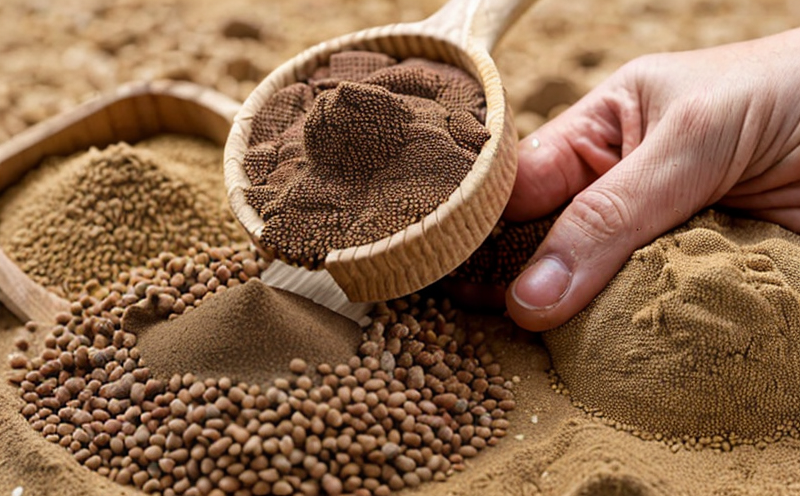Ash Content Testing in Animal Feed
The ash content of animal feed is a critical parameter that reflects the mineral content present in the ingredients used. This test plays a vital role in ensuring the quality and safety of animal feeds, which directly impact the health and performance of livestock animals like poultry, pigs, and cattle.
Ash content refers to all non-combustible residues left after the complete combustion of feed samples at specific temperatures (typically 550°C). This includes minerals such as calcium, phosphorus, magnesium, potassium, sodium, iron, copper, zinc, and other trace elements. These mineral components are essential for animal nutrition because they contribute to bone formation, muscle development, and overall health.
Compliance with regulatory requirements is paramount in the agriculture sector. For instance, the Codex Alimentarius sets standards for feed products globally, which include limits on certain ash content levels based on the type of animal being fed. Incorrect ash content can lead to over-supplementation or under-supplementation of minerals, affecting animal health and productivity.
The testing process involves precise sample preparation, combustion, and accurate weighing of the residue. The apparatus used includes muffle furnaces capable of reaching high temperatures for complete combustion and analytical balances with micro-grams readability for precise weight measurements. The method follows ISO standards such as ISO 6860:2019 which provides detailed procedures.
- Sample preparation involves grinding the feed sample into a fine powder to ensure uniform combustion.
- The sample is then weighed accurately and placed in a crucible.
- The crucible is subjected to high-temperature combustion (550°C) in an oxygen-rich environment.
- The cooled residue, representing ash content, is weighed again for accurate measurement.
Understanding the ash content also helps in optimizing feed formulations by balancing mineral intake with overall nutritional requirements. By knowing the exact amount of minerals present, formulators can adjust the mix to meet specific dietary needs and avoid excesses that could lead to health issues like kidney stones or reduced palatability.
Why It Matters
The accurate measurement of ash content is crucial for maintaining animal health and productivity. Ensuring that feeds meet specific regulatory requirements helps prevent potential hazards such as toxic metal contamination, which can lead to severe health issues in livestock. Additionally, consistent ash levels indicate optimal feed formulations, promoting efficient nutrient absorption and reducing waste.
From a business perspective, compliance with international standards enhances the reputation of the company among clients and stakeholders. It also minimizes risks associated with non-compliance penalties or recalls due to quality issues. By investing in reliable testing services, companies can build trust and ensure long-term sustainability within the industry.
Benefits
Implementing ash content testing offers numerous benefits that contribute positively to both business operations and animal welfare:
- Improved Feed Quality: Ensures proper mineral balance, enhancing animal health and performance.
- Regulatory Compliance: Prevents non-compliance with international standards, avoiding legal penalties.
- Promoted Animal Welfare: Reduces the risk of nutritional deficiencies or toxic metal overloads.
- Enhanced Reputation: Builds trust with consumers and stakeholders by delivering high-quality products.
- Sustainable Operations: Optimizes feed formulations, reducing waste and operational costs.
In summary, thorough ash content testing is essential for maintaining the integrity of animal feeds, thereby supporting sustainable agricultural practices and contributing to overall industry growth.
Use Cases and Application Examples
| Feed Type | Ash Content Range (grams per 100 grams) | Application Example |
|---|---|---|
| Poultry Feed | 8-12% | Testing ash content ensures adequate calcium and phosphorus levels for bone development. |
| Pig Feed | 4-9% | Proper mineral balance is crucial for pig growth and reproductive health. |
| Cattle Feed | 2.5-7% | Adequate ash content supports calcium absorption necessary for skeletal development in young cattle. |
| Date of Testing | Sample ID | Ash Content (grams per 100 grams) | Comments |
|---|---|---|---|
| 2023-08-15 | SF123456 | 9.7% | Within acceptable range for cattle feed. |
| 2023-08-20 | SF123457 | 11.2% | High end of acceptable range, requiring review. |
| 2023-08-25 | SF123458 | 7.8% | Low end of acceptable range, further validation required. |





